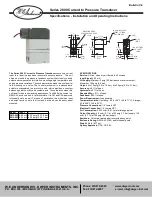
TK-3260EX
Frequency.and.Signaling
The transceiver has been adjusted for the frequencies
shown in the following table. When required, re-adjust them
following the adjustment procedure to obtain the frequencies
you want in actual operation.
n
.Frequency.(MHz)
Channel.No.
RX.Frequency
TX.Frequency
1
455.050
455.100
2
440.050
440.100
3
469.950
469.900
4
455.000
455.000
5
455.200
455.200
6
455.400
455.400
7~16
-
-
n
.Signaling
Signaling.No.
RX
TX
1
None
None
2
None
100Hz Square Wave
3
QT 67.0Hz
QT 67.0Hz
4
QT 151.4Hz
QT 151.4Hz
5
QT 210.7Hz
QT 210.7Hz
6
QT 254.1Hz
QT 254.1Hz
7
DQT D023N
DQT D023N
8
DQT D754I
DQT D754I
9
DTMF 159D
DTMF 159D
10
None
DTMF tone9
11
-
-
12
None
Single Tone:1000Hz
13
None
MSK
14
MSK Code
MSK Code
Preparations.for.Tuning.the.Transceiver
Before attempting to tune the transceiver, connect the unit
to a suitable power supply.
Whenever the transmitter is tuned, the unit must be con-
nected to a suitable dummy load (i.e. power meter).
The speaker output connector must be terminated with a
16
Ω
dummy load and connected to an AC voltmeter and an
audio distortion meter or a SINAD measurement meter at all
times during tuning.
ADJUSTMENT
n
.List.of.FPU.for.transceiver
Model
Type
FPU
TK-3260EX
E
KPG-123D
• PC tuning
Connect the wires to the PCB in the connector case of
interface cable.
For output the wires out of the connector case, need to
process the connector case.
Connector case
KPG-36/36A
Remove the
screw
PCB layout
Shield
AF voltmeter
Audio generator
100
μ
10V
100
μ
10V
10
μ
10V
+
+
+
16
Ω
































